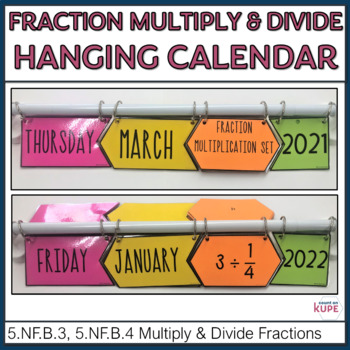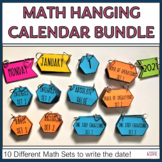Fraction Multiplication and Division Math Hanging Classroom Calendar
- PDF
Also included in
- Integrate math in everyday with a math calendar! Each calendar has 31 different questions for students to solve to figure out the date! It could be a fun "do now" to have the students show their work and solve the math problem of the day.All the days of the week, months of the year, questions with aPrice $28.00Original Price $46.75Save $18.75
Description
Integrate math in everyday with a math calendar! This calendar has 31 fraction multiplication questions and 31 fraction division questions for students to solve to figure out the date! It could be a fun "do now" to have the students show their work and solve the math problem of the day.
All the days of the week, months of the year, fraction multiplication and division questions with answers 1-31, and years 2021-2031 are included in the download. There are two different sets included: multiplying fractions and dividing fraction numbers.
I love how the pieces fit together so perfectly! The pieces come in black and white and is easily printed on colored paper to match your classroom theme! Just a little prep that will save you tons of time during the year!
How to make the hanging calendar display:
1. Purchase a magnetic curtain rod (I got mine from amazon 16-28" and am using the smallest setting) and 1" binder rings.
2. Print the pieces on any color you like! You can use regular weight paper.
3. Laminate all the pieces.
4. Punch holes in the corners of the pieces for the binder rings.
5. Hang the rings on the curtain rod and enjoy never writing the date again!
Learn More about how to use the resource:
- 3 Ways to Use the Daily Math Calendar
Save money and buy the bundle!
- Math Hanging Calendar Bundle
Other products you might like:
- Math Reference Bulletin Board (with hexagons!)
- Math Affirmation Bulletin Board
- Real World Math Project & Bulletin Board
Are you using one of my products? Post one on Instagram and tag me @countonkupe so I can share!
If you would like to see my products in action, check out my website COUNT ON KUPE. Questions? Email me at annette@countonkupe.com
** How to get TPT credit to use on future purchases **
Go to your My Purchases page. Beside each purchase, you will see a “Provide Feedback” button. Click it and give a rating and leave a comment! You will have credits to use on future purchases.
** Be the first to hear about my new products and discounts! **
Click HERE to become a follower. You will then see my updates!
Let me know what you think!
Happy Teaching!






